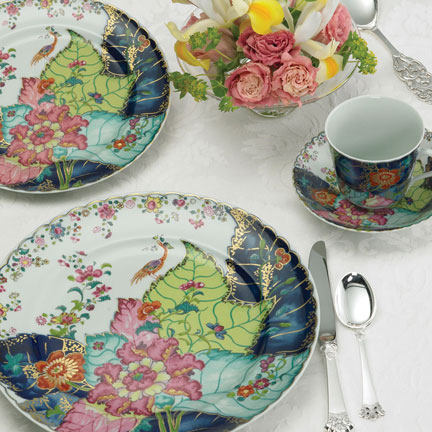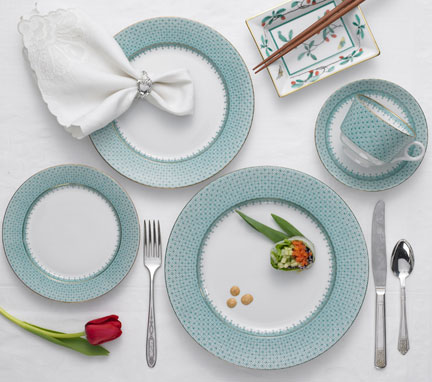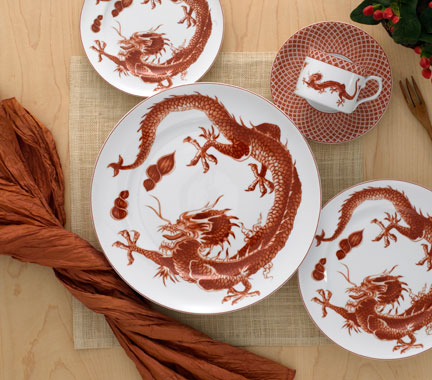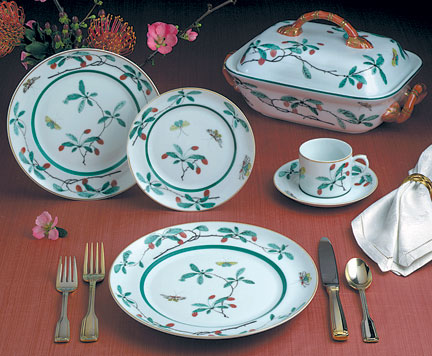Save to...
Museum Reproductions from Mottahedeh Porcelain Dinnerware
We love the rich, colorful patterns of Mottahedeh’s porcelain dinnerware. A favorite of bridal registries, the company has an interesting history to go along with their beautiful dishes. The company was founded by a husband and wife, Rafi and Mildred Mottahedeh, who were avid collectors of antique porcelain. They began by making reproductions of museum pieces, available for sale in museum gift shops. Later, entire dinnerware collections were designed from antique patterns. Often one solitary plate would be the inspiration for a new design.
Mottahedeh patterns are known for their complex and vibrant colors, often with hand-painted gold decoration. The pieces are surprisingly fresh and timely, and look wonderful in both contemporary and traditional dining rooms. Having withstood the test of time already, they are sure to endure for many more generations.
Here our some of the most popular patterns:

Tobacco Leaf, named for its vivid illustrations of the Nicotiana (Tobacco) plant, is based on a style of 18th century Chinese export porcelain. The bright colors and elegant patterns are thought to have been styled in the manner of Indian fabrics. Tobacco Leaf looks so fresh, it’s hard to believe it’s actually a reproduction of antique china at the Metropolitan Museum of Art. That’s what we call timeless style at its best!

Blue and white has always been stylish, even as far back as 1200 AD China! Blue Canton Dinnerware captures the rich cobalt blue of the original “Blue Canton Ware” – named for the Chinese port from which it was shipped. In the early 19th century, this detailed blue china was seen on the most fashionable tables in the early American Republic. Mottahedeh’s reproduction is faithful in every detail, right down to the signature greyish-blue color of the porcelain. These plates look just as beautiful on the dinner table as they do displayed on the wall.

Lace is always a classic look, and here we have it in four color options: Blue, Cornflower, Green (shown above) and Apple Green. This versatile pattern with its delicate border was inspired by Ch’ing Dynasty porcelain from China. Highlighted by bands of 22K gold, this elegant dinnerware makes a stunning presentation and coordinates beautifully with the other Mottahedeh patterns. The subtle colors are just right for spring entertaining.

Cinnabar, or Chinese Red, gives a unique color to the Red Dragon pattern, inspired by the Year of the Dragon. According to ancient Chinese culture the dragon symbolizes benevolence, protection and good fortune. This symbol was predominately used for the emperor, and originated in a design from the K’ang Hsi period.

The graceful design of Famille Verte dinnerware, with its leaves, berries and butterflies, was inspired by a piece of Chinese imperial palace porcelain of the early 18th century. Much of the porcelain produced in China during the reign of the Kang His emperor had “famille verte” decoration – painted in transparent enamels predominantly in shades of green. Famille Verte is a versatile pattern that looks great all year long.
The Mottahedehs believed that beauty and art should be available to everyone, not just the very rich. Today the company, headed by affable owner Wendy Kvalheim, still follows that philosophy, and the collections are very affordable. They are also quite durable and made to be used and enjoyed rather than packed away in a cupboard. We think the Mottahedehs had the right idea on both counts! We hope you enjoy their dinnerware as much as we do.
To see more Mottahedeh designs, click here.
